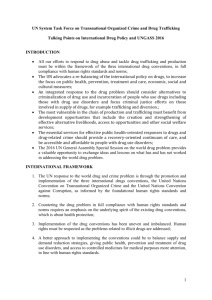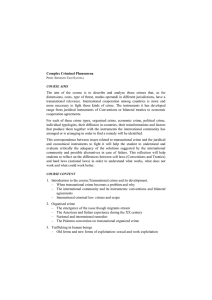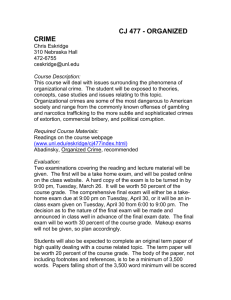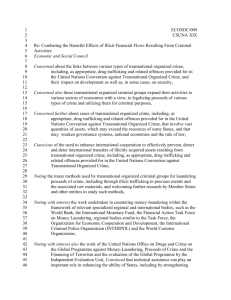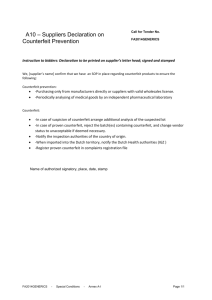Sandro Calvani - Organized Crime Impact
advertisement
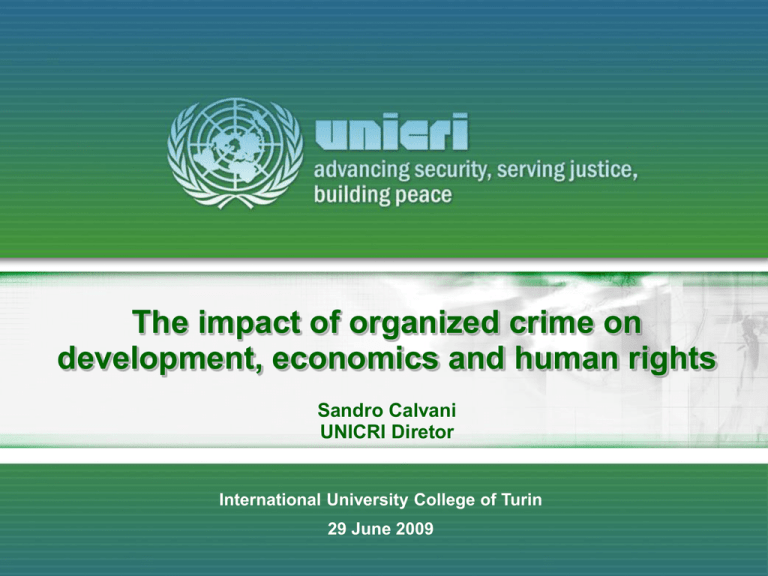
The impact of organized crime on development, economics and human rights Sandro Calvani UNICRI Diretor International University College of Turin 29 June 2009 Table of contents • Definition of crime • Global public goods • Security and development • Crime and economics • Two collective security challenges: - transnational organized crime - terrorism • Transnational organized crime • Obstacles for the international community • Terrorism • Trafficking in weapons and in human beings • International instruments • UN Convention against Transnational Organized Crime • Conclusions 2 Definition of crime An act (of commission and omission) violating a law, hence deemed illegal, to which the judicial system attributes a penalty. Current impact of crime What impact does crime have nowadays on the complex interconnections between economics, development and rights? 3 Global public goods: Security Development Economy Human rights 4 Security and development are interdependent •Crimes against natural or cultural heritage can discourage foreign investment •Illegally exploiting natural resources of countries that are experiencing war or that are in the process of developing can seriously hinder reconstruction efforts. •Corruption as an obstacles to increasing wealth poses severe limitations on development. 5 Crime and Economics Raising interconnections between organized crime and economic crimes Speculative manoeuvres concerning goods in the economic and financial realm Building without planning permissions and illicit waste trafficking Counterfeiting (technology, software, banknotes, pharmaceuticals, cars, cigarettes, watches…) Abuse of public powers (corruption, extortion, embezzlement) 6 Collective security: two main challenges Transnational organized crime Terrorism 8 Globalization of economy and transnationality of crime 7 Transnational organized crime A direct threat to States and to human security Among the main transnational criminal activities: drug trafficking worth $ 300-500 billion (as much as some countries’ GDP) contributes to the alarming spread of HIV/AIDS revenues from opium industry finance terrorist groups (i.e. Afghanistan) 9 Emerging crimes as a threat to a development, economics and human rights 10 Emerging crimes Crime Bln. $ Crime Bln. $ 1. Marijuana 2. Counterfeit Technology 3. Cocaine 4. Opium/Heroin 5. Web Video Piracy 6. Smuggled Cigarettes 7. Software Piracy 8. Counterfeit Pharm. Drugs 9. Human Trafficking 10. Amphetamines 11. Animals smuggling 12. Movie Piracy 13. Illegal Fishing 14. Ecstasy 15. Illegal Logging 141.8 100 70.45 64.82 60 50 47.8 40 32 28.25 20 18.2 16.5 16.07 15 16. Counterfeit Auto Parts 17. Trash Smuggling 18. Human Smuggling 19. Arms Trafficking 20. Art Smuggling 21. Counterfeit Clothes 22. Gas and Oil Smuggling 23. Music Piracy 24. Counterfeit Cigarettes 25. Pirated Mobile Phone Entert 26. Counterfeit Cosmetics 27. Video Game Piracy 28. Counterfeit Airline Parts 29. Cable Piracy 30. International Adoptions 12 11 10 10 10 8.24 6.2 4.5 4 3.4 3.0 3.0 2.0 1.54 1.3 11 Emerging crimes Crime 31. Counterfeit Shoes 32. Counterfeit Watches Mln. $ 920 655 Crime Mln. $ 40. Counterfeit Cuban Cigars 100 41. Nuclear Smuggling 100 33. Counterfeit pesticides 650 42. Counterfeit Purses 70 34. Book Piracy 600 43. Counterfeit Dollars 61 35. Counterfeit Sports Mem. 500 44. Organ Trafficking 50 36. Kidnap and Ransom 500 45. Counterfeit Lighters 42 37. Counterfeit Alcohol 300 46. Counterfeit Batteries 23 38. Diamond Smuggling 280 47. Human Tissue and Parts 6 39. Counterfeit Toys 131 48. Counterfeit Money Orders 3.7 12 Obstacles for the international community 1) Insufficient cooperation between States 2) Weak coordination between international agencies 3) Inadequate efforts of many countries Also complicated by structural and organizational changes: from formal hierarchies to fluid networks 13 Terrorism Threatens the core values of the United Nations Charter: respect for human rights rule of law humanitarian law protecting civilians tolerance between peoples and nations peaceful resolution of conflicts 14 Terrorism thrives in contexts of: despair humiliation poverty regional conflict foreign occupation State failure political oppression extremism human rights abuses 15 New factors heightening the threat of terrorism: Armed non-governmental networks with global outreach and sophisticated capacities (i.e. Al-Qaeda) Mass-casualty attacks 16 Trafficking Trafficking in weapons and violence in war-torn countries. Human trafficking and the difficulties in distinguishing illegal phenomena within migration movements. International instruments and the search for a common international definition of terrorism and victims’ protection. 17 Arms trafficking • $ 10 billion - illegal arms trafficking • $ 1-4 billion - illegal trade in small weapons • 2 million people involved in illicit arms trafficking • 2000 U.S. weapons smuggled into Mexico by drug traffickers daily • 140.000 illegally smuggled weapons in Kenya • 1 million lost/stolen light weapons end up on the black market • 60% of the arms illegally trafficked originate from a legal transaction 18 Human trafficking and distinguishing illegal phenomena in migrations Trafficking in persons: • coercion (without victims’ consent) • exploitation (for labour or sexual purposes) • may be transnational or internal Smuggling in persons: • consensual • cross-border • ends with arrival at destination 19 Human trafficking • 2.7 million victims a year • 80% of the victims are women • 50% of the victims are minor • $ 9.5 billion turnover a year Fonte: Vienna Forum To Fight Human Trafficking, Feb 2008; TIP report 2007 20 International instruments 1945 United Nations Charter 1948 The Universal Declaration of Human Rights 1951 Convention on the Prevention and Punishment of the Crime of Genocide 1966 The UN International Covenant on Civil and Political Rights 1969 Convention on the Elimination of All Forms of Racial Discrimination 1976 The UN International Covenant on Economic, Social and Cultural Rights 1981 Convention on the Elimination of All Forms of Discrimination Against Women 1984 UN Convention Against Torture 1989 Convention on the Rights of the Child 2002 Rome Stature on the International Criminal Court 21 International instruments: The United Nations Convention against Transnational Organized Crime (Palermo-2000) • Protocol to Prevent, Suppress and Punish Trafficking in Persons, Especially Women and Children, supplementing the United Nations Convention against Transnational Organized Crime • Protocol against the Smuggling of Migrants by Land, Air and Sea, supplementing the United Nations Convention against Transnational Organized Crime • Protocol against the Illicit Manufacturing and Trafficking in Firearms, Their Parts and Components and Ammunition, supplementing the United Nations Convention against Transnational Organized Crime 22 Conclusions - To contrast organized crime, must address the transnational dimension - Need COOPERATION 23 www.unicri.it Thank you for your attention 23
